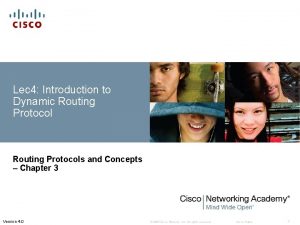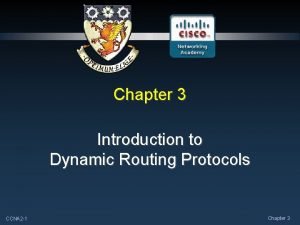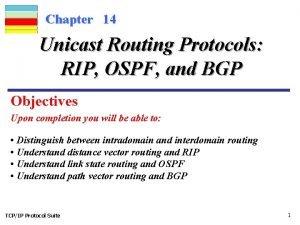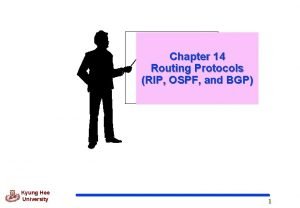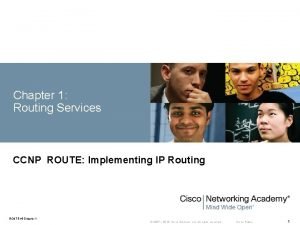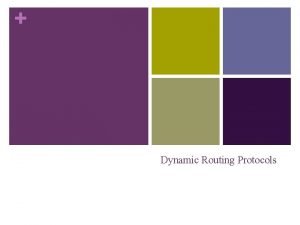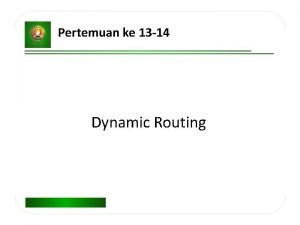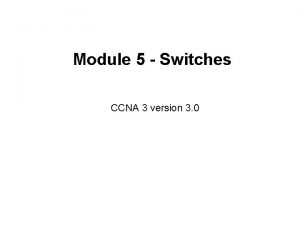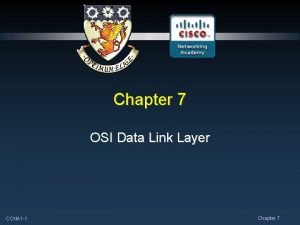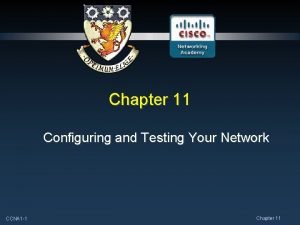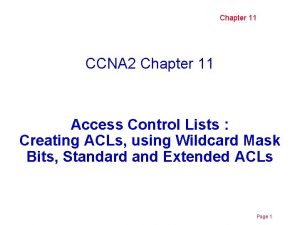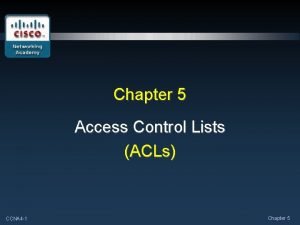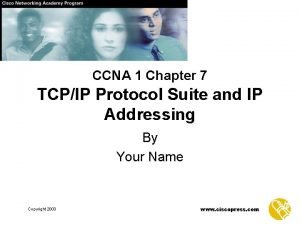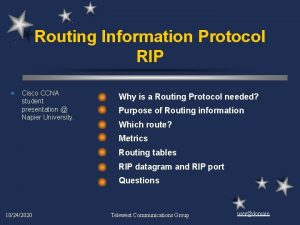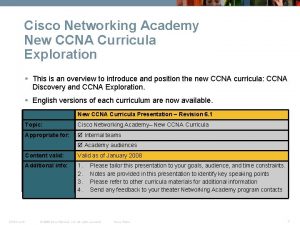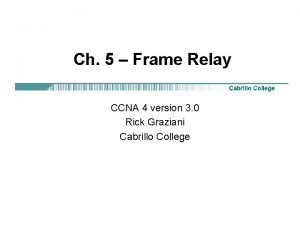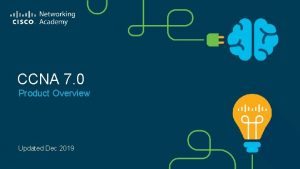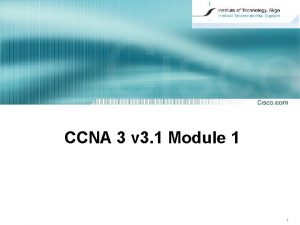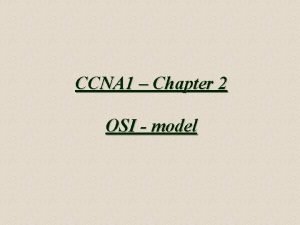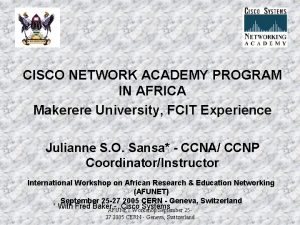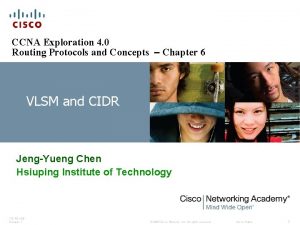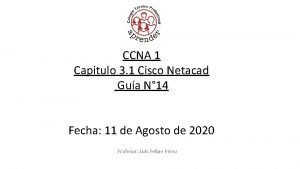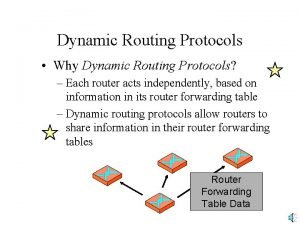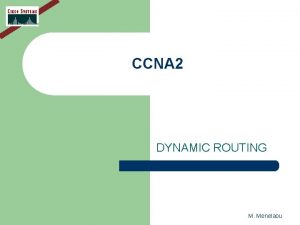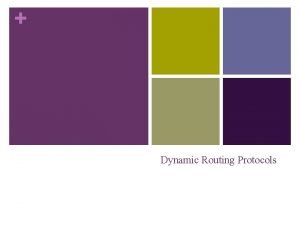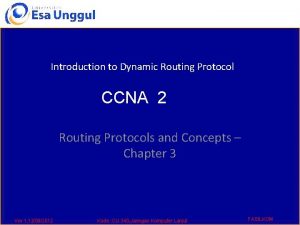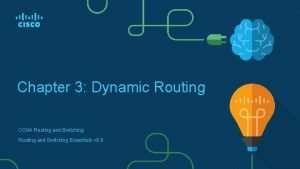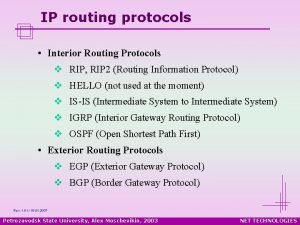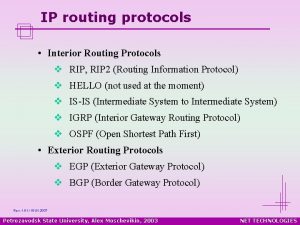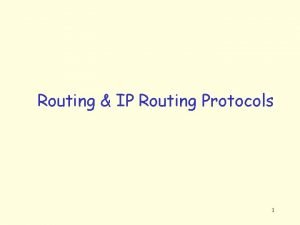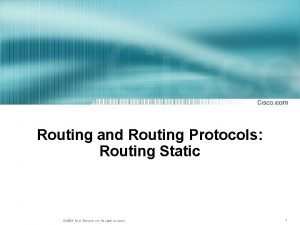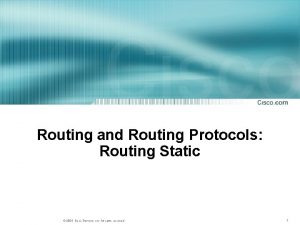Chapter 3 Introduction to Dynamic Routing Protocols CCNA














































- Slides: 46

Chapter 3 Introduction to Dynamic Routing Protocols CCNA 2 -1 Chapter 3

Note for Instructors • These presentations are the result of a collaboration among the instructors at St. Clair College in Windsor, Ontario. • Thanks must go out to Rick Graziani of Cabrillo College. His material and additional information was used as a reference in their creation. • If anyone finds any errors or omissions, please let me know at: • tdame@stclaircollege. ca. CCNA 2 -2 Chapter 3

Introduction to Dynamic Routing Protocols CCNA 2 -3 Chapter 3

Perspective and Background • Dynamic routing protocols have evolved over several years. • As networks have evolved and become more complex, new routing protocols have emerged. • The first version of RIP was released in 1982, but some of the basic algorithms within the protocol were used on the ARPANET as early as 1969. CCNA 2 -4 Chapter 3

Role of Dynamic Routing Protocol • Exchange of routing information between routers. • Dynamically learn information about remote networks and add routes to routing tables. • Determines the best path to each network. • Automatically finds alternate paths if needed. CCNA 2 -5 Chapter 3

Role of Dynamic Routing Protocol • Advantages over Static Routes: • Less administrative overhead. • Scales better. • Less prone to configuration errors. CCNA 2 -6 Chapter 3

Network Discovery and Routing Table • Components of Dynamic Routing Protocols: • Data Structures: • Tables or databases for their operations, kept in RAM. • Algorithm: • An algorithm is a finite list of steps used in accomplishing a task. • Used for processing routing information and for bestpath determination. • Routing Protocol Messages: • Discover neighboring routers. • Exchange, learn and maintain accurate network routing information. CCNA 2 -7 Chapter 3

Dynamic Routing vs Static Routing CCNA 2 -8 Chapter 3

Introduction to Dynamic Routing Protocols Classifying Dynamic Routing Protocols CCNA 2 -9 Chapter 3

Classifying Dynamic Routing Protocols Exterior Gateway Interior Gateway Distance Vector Link State Path Vector Classful RIP IGRP Classless RIPv 2 EIGRP OSPFv 2 IS-IS BGPv 4 IPv 6 RIPng EIGRP for IPv 6 OSPFv 3 IS-IS for IPv 6 BGPv 4 for IPv 6 CCNA 2 -10 EGP Chapter 3

Classifying Dynamic Routing Protocols • Concept of Autonomous Systems (AS): A network or group of networks identified and administered as a single entity. CCNA 2 -11 Chapter 3

Classifying Dynamic Routing Protocols • IGP vs. EGP Routing Protocols: Allow one AS to exchange routing information with another AS. Allow routers within an AS to exchange information. CCNA 2 -12 Chapter 3

Classifying Dynamic Routing Protocols Exterior Gateway Interior Gateway Distance Vector Link State Path Vector Classful RIP IGRP Classless RIPv 2 EIGRP OSPFv 2 IS-IS BGPv 4 IPv 6 RIPng EIGRP for IPv 6 OSPFv 3 IS-IS for IPv 6 BGPv 4 for IPv 6 CCNA 2 -13 EGP Chapter 3

Distance Vector and Link State • Distance Vector: • Routes are advertised as vectors of distance and direction. • Distance: • Is defined in terms of a metric. • Hop Count: The number of routers between the source and destination networks. • Direction: • Is simply the next-hop router or exit interface. • Routing updates usually consist of periodic updates of the entire routing table. CCNA 2 -14 (e. g. . Routing Information Protocol - RIP – every 30 seconds) Chapter 3

Distance Vector and Link State • Distance Vector: or update timer expires CCNA 2 -15 Chapter 3

Distance Vector and Link State • Distance Vector: • The network is simple and flat and does not require a hierarchical design. • The administrators do not have enough knowledge to configure and troubleshoot link-state protocols. • Specific types of networks, such as hub-and-spoke networks, are being implemented. • Worst-case convergence times in a network are not a concern. CCNA 2 -16 Chapter 3

Distance Vector and Link State • Link State: • A Link State routing protocol can create a complete map of the network topology. • A link-state router: • Receives an update. • Builds a topology database. • Uses a Shortest Path First (SPF) algorithm to create its view of the network. • Builds the routing table. • Routing updates (not the entire table) are only sent to neighbouring routers when the topology changes. CCNA 2 -17 (e. g. . Open Shortest Path First - OSPF) Chapter 3

Distance Vector and Link State • Link State: CCNA 2 -18 Chapter 3

Distance Vector and Link State • Link State: • The network design is hierarchical, usually occurring in large networks. • The administrators have a good knowledge of the implemented link-state routing protocol. • Fast convergence of the network is crucial. CCNA 2 -19 Chapter 3

Classifying Dynamic Routing Protocols Exterior Gateway Interior Gateway Distance Vector Link State Path Vector Classful RIP IGRP Classless RIPv 2 EIGRP OSPFv 2 IS-IS BGPv 4 IPv 6 RIPng EIGRP for IPv 6 OSPFv 3 IS-IS for IPv 6 BGPv 4 for IPv 6 CCNA 2 -20 EGP Chapter 3

Classful and Classless • Classful Protocols: • Do not send subnet mask information in routing updates. • The subnet mask must be the same throughout the entire topology. • IP Addresses were first allocated based on classes (A, B or C). • The first routing protocols (RIP) did not need to transmit the subnet mask because of the address class distinction. • Network mask could be determined based on value of first octet of the network address. • VLSM and CIDR are not possible. CCNA 2 -21 Chapter 3

Classful and Classless • Classless Protocols: • Include subnet mask information in routing updates. • The subnet mask does not have to be the same throughout the entire topology. • Today’s networks are no longer allocated based on the address class. • The subnet mask can no longer be determined by the first octet of the IP Address. CCNA 2 -22 • VLSM and CIDR are possible. Chapter 3

Classifying Dynamic Routing Protocols Exterior Gateway Interior Gateway Distance Vector Link State Path Vector Classful RIP IGRP Classless RIPv 2 EIGRP OSPFv 2 IS-IS BGPv 4 IPv 6 RIPng EIGRP for IPv 6 OSPFv 3 IS-IS for IPv 6 BGPv 4 for IPv 6 CCNA 2 -23 EGP Chapter 3

Dynamic Routing Protocols and Convergence • Convergence: • The network has converged when all routers have complete and accurate information about the network. • The speed of convergence is an important characteristic of a network. CCNA 2 -24 Chapter 3

Dynamic Routing Protocols and Convergence • Convergence: • The routers must: • Share routing information. • Calculate the best path to a destination. • Update their routing tables. CCNA 2 -25 Chapter 3

Dynamic Routing Protocols and Convergence • Convergence: • Generally: • Slower Convergence: RIP • Faster Convergence: EIGRP and OSPF CCNA 2 -26 Chapter 3

Introduction to Dynamic Routing Protocols Metrics ? ? CCNA 2 -27 ? Chapter 3

Purpose of a Metric To route to. . ? • There are times when a router will have multiple paths to the same destination. • Metrics are a way to measure and/or compare routes to determine which route is the best path. CCNA 2 -28 Chapter 3

Purpose of a Metric To route to. . ? • The route chosen will depend on two things: • The routing protocol in use. • The metric used by the routing protocol. CCNA 2 -29 Chapter 3

Metrics and Routing Protocols 172. 16. 2. 0/24 Network 172. 16. 2. 0 is: This is the 1 hop. Ivia route will. R 2 use. 2 hops via R 3 • Routing Information Protocol (RIP): • Uses hop count as its metric. Lower is better. CCNA 2 -30 Chapter 3

Metrics and Routing Protocols 172. 16. 2. 0/24 The route to network 172. 16. 2. 0/24 is: the This is 56 Kbps R 2 route through I will use. 1. 54 Kbps through R 3 • Open Shortest Path First (OSPF): • Uses bandwidth as its metric. Faster is better. CCNA 2 -31 Chapter 3

Metric Filed in the Routing Table • The routing table displays the metric for each dynamic and static route. • Dynamic routes with the lowest metric are installed by routing protocols. • Static routes always have a metric of 0. CCNA 2 -32 Chapter 3

Metric Field in the Routing Table • All routers are running RIP. • R 2 has a route to 192. 168. 8. 0 and is 2 hops away. CCNA 2 -33 Chapter 3

Load Balancing • What happens when two or more routes to the same destination have identical metric values? • The router load balances among all equal-cost paths. CCNA 2 -34 Chapter 3

Introduction to Dynamic Routing Protocols Administrative Distance CCNA 2 -35 Chapter 3

Purpose of Administrative Distance (AD) • Routers learn about adjacent networks that are directly connected and about remote networks by using static routes and dynamic routing protocols. • A router might learn of a route to the same network from more than one source. CCNA 2 -36 Chapter 3

Purpose of Administrative Distance (AD) • Routers learn about adjacent networks that are directly connected and about remote networks by using static routes and dynamic routing protocols. • A router might learn of a route to the same network from more than one source. • Three types of Routing Sources. • Direct Connect • Static • Dynamic Routing Protocol CCNA 2 -37 Route Source AD Direct Connect 0 Static 1 EIGRP Summary 5 External BGP 20 Internal EIGRP 90 OSPF 110 IS-IS 115 RIP 120 External EIGRP 170 Internal BGP 200 Chapter 3

Purpose of Administrative Distance (AD) • Administrative Distance is used to determine which route is to be installed in the routing table. • The route that has the lower AD will be preferred over the route with the higher AD and will be added to the routing table. • The term trustworthy is commonly used when defining administrative distance. • The lower the administrative distance value, the more “trustworthy” the route. CCNA 2 -38 Route Source AD Direct Connect 0 Static 1 EIGRP Summary 5 External BGP 20 Internal EIGRP 90 OSPF 110 IS-IS 115 RIP 120 External EIGRP 170 Internal BGP 200 Chapter 3

Multiple Routing Sources • For Example: Route Source • A route to a network is learned Direct Connect by the configuration of a static Static route. EIGRP Summary • Another route (or the same External BGP route) to the same network is Internal EIGRP learned when OSPF is enabled OSPF on the router. IS-IS • Static Route AD = 1 RIP • OSPF AD = 110 External EIGRP • The static route will be added Internal BGP to the routing table and the route learned from OSPF will be ignored. CCNA 2 -39 AD 0 1 5 20 90 115 120 170 200 Chapter 3

Multiple Routing Sources • While not as common, R 2 above has learned routes to network 192. 168. 6. 0/24 from EIGRP (AD 90) and from RIP (AD 120). • The route learned from EIGRP will be installed in the routing table. CCNA 2 -40 Chapter 3

Verifying Administrative Distance (AD) • show ip route AD = 0 CCNA 2 -41 Chapter 3

Verifying Administrative Distance (AD) • show ip protocols CCNA 2 -42 Chapter 3

Static Routes and Administrative Distance • Static Route AD = 1 • After directly connected networks (AD = 0), static routes are the most preferred route source. CCNA 2 -43 Chapter 3

Static Routes and Administrative Distance Exit Interface: ip route 172. 16. 3. 0 255. 0 serial 0/0/0 Next-hop Address: ip route 172. 16. 3. 0 255. 0 192. 168. 1. 1 • Routing table display depends on how you issued the command. The AD for both of these is 1! CCNA 2 -44 Chapter 3

Directly Connected and Administrative Distance • Appear in the routing table as soon as the interface is active with an IP address and subnet mask (“up” and “up”). • AD = 0 is the most preferred route. • Cannot be changed • No other type of route can have AD = 0. • There is no better route for a router than having one of its interfaces directly connected to that network. CCNA 2 -45 Chapter 3

Directly Connected and Administrative Distance • To see the AD value of any network, use the command show ip route [route] option. • Directly Connected • Static • Dynamic Routing Protocol CCNA 2 -46 Chapter 3
 Introduction to dynamic routing protocols
Introduction to dynamic routing protocols Static routing and dynamic routing
Static routing and dynamic routing Routing protocols administrative distance
Routing protocols administrative distance Write a detailed note on unicast routing protocols
Write a detailed note on unicast routing protocols Routing protocols rip ospf bgp
Routing protocols rip ospf bgp Ppdioo
Ppdioo Lab 4-1: routing concepts and protocols
Lab 4-1: routing concepts and protocols Routing fabric
Routing fabric Routing and switching protocols
Routing and switching protocols Inter vlan routing layer 3 switch
Inter vlan routing layer 3 switch Routing protocols
Routing protocols Goodrich method
Goodrich method Hydrologic routing and hydraulic routing
Hydrologic routing and hydraulic routing Clock and power routing in vlsi
Clock and power routing in vlsi Igrp configuration in packet tracer
Igrp configuration in packet tracer Rip static
Rip static Linux dynamic routing
Linux dynamic routing Dynamic routing
Dynamic routing Ccna 3 chapter 1
Ccna 3 chapter 1 What is a function of the data link layer ccna
What is a function of the data link layer ccna Ccna 4 chapter 4
Ccna 4 chapter 4 Ccna security chapter 1
Ccna security chapter 1 Ccna 4 chapter 1
Ccna 4 chapter 1 Ccna chapter 7
Ccna chapter 7 Ccna chapter 11
Ccna chapter 11 Ccna 1 chapter 4
Ccna 1 chapter 4 Ccna 4 chapter 4
Ccna 4 chapter 4 Ccna 2 chapter 11
Ccna 2 chapter 11 Ccna 4 chapter 5
Ccna 4 chapter 5 Ccna 1 chapter 7
Ccna 1 chapter 7 Chapter 3 network protocols and communications
Chapter 3 network protocols and communications Transferered
Transferered Drug and alcohol jeopardy
Drug and alcohol jeopardy Ccna
Ccna Ccna 640
Ccna 640 Rip student
Rip student Cisco ccna exploration
Cisco ccna exploration Ccna frame relay
Ccna frame relay Ccna exploration network fundamentals
Ccna exploration network fundamentals Assessmentlauncher
Assessmentlauncher Ccna module 1
Ccna module 1 Osi model ccna
Osi model ccna Ccna makerere university
Ccna makerere university Ccna 3 scaling networks ppt
Ccna 3 scaling networks ppt Ccna voice 640-461 pdf
Ccna voice 640-461 pdf Ccna exploration 4
Ccna exploration 4 Netacad que es
Netacad que es
